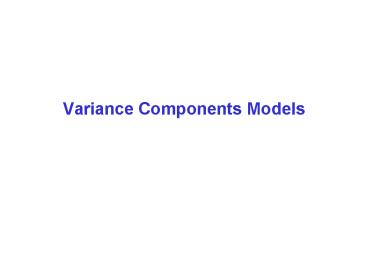Variance Components Models - PowerPoint PPT Presentation
1 / 23
Title:
Variance Components Models
Description:
... influence of a suspected outlier by comparing results after its removal ... only 20 level 2 units. 22. Estimation of a Multilevel Model. 23. The IGLS Algorithm ... – PowerPoint PPT presentation
Number of Views:150
Avg rating:3.0/5.0
Title: Variance Components Models
1
Variance Components Models
2
Aims of a Variance Components Analysis
- Estimate the amount of variation between groups
(level 2 variance) relative to within groups
(level 1 variance) - How much variation is there in life expectancy
between and within countries? - How much of the variation in student exam scores
is between schools? i.e. is there within-school
clustering in achievement? - Compare groups
- Which countries have particularly low and high
life expectancies? - Which schools have the highest proportion of
students achieving grade A-C, and which the
lowest? - As a baseline for further analysis
3
Revision of Fixed Effects Approach
4
Limitations of the Fixed Effects Approach
5
Multilevel (Random Effects) Model
6
Individual (e) and Group (u) Residuals in a
Variance Components Model
7
Partitioning Variance
8
Model Assumptions
9
Intra-class Correlation
10
Examples of ?
? 0.8
? 0.4
? 0
11
Example Between-Country Differences in Hedonism
12
Testing for Group Effects
13
Example Testing for Country Differences in
Hedonism
14
Residuals in a Variance Components Model
15
Level 2 Residuals
16
Shrinkage
17
Example Mean Raw Residuals vs. Shrunken
Residuals for Countries
In this case, there is little shrinkage because
nj is very large.
18
Example Caterpillar Plot showing Country
Residuals and 95 CIs
19
Residual Diagnostics
- Use normal Q-Q plots to check assumptions that
level 1 and 2 residuals are normally distributed - Nonlinearities suggest departures from normality
- Residual plots can also be used to check for
outliers at either level - Under normal distribution assumption, expect 95
of standardised residuals to lie between -2 and
2 - Can assess influence of a suspected outlier by
comparing results after its removal
20
Example Normal Plot of Individual (Level 1)
Residuals
Linearity suggests normality assumption is
reasonable
21
Example Normal Plot of Country (Level 2)
Residuals
Some nonlinearity but only 20 level 2 units
22
Estimation of a Multilevel Model
23
The IGLS Algorithm































